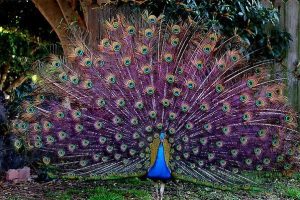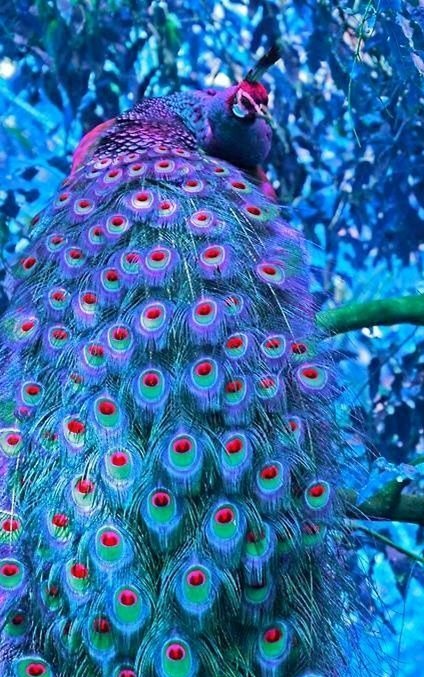
While most people are familiar with the common blue peacock, there is a lesser-known variety that is just as stunning: the purple peacock.
In this blog post, we will provide an overview of purple peacocks, including some interesting facts and the symbolism associated with these magnificent birds.
The purple peacock, also known as the Burmese peacock, is a subspecies of the Indian peafowl. It is native to Southeast Asia, particularly in Burma, Thailand, and parts of Indonesia. Like other peafowl, the purple peacock is a large bird, with males (peacocks) reaching up to three feet in length and females (peahens) being slightly smaller.
As a peacockfarm owner, my recent visit to Purple Peacock boss was quite an interesting experience. The farm is located in a lush green area with an expansive landscape, well-manicured lawns, and a beautiful pond that adds to the natural beauty of the environment.
The Purple peacocks in Peacockboss are well taken care of, with large and spacious enclosures that allow them to move around freely. The birds appear healthy and happy, with their feathers shining in the sun. The staff at Peacockboss seem to be knowledgeable and passionate about the birds, providing them with the best care possible.
One of the most remarkable things I noticed at Peacockboss was the variety of peacock breeds they had. They had not only the common Indian Blue peacock but also several rare and exotic peacock breeds from around the world, such as the white peacock, Pink Peacock, Red Peacock, Golden Peacock, green peacock, and Java green peacock.
Moreover, the farm had an impressive collection of peacock feathers of different colors and sizes, which they sell as souvenirs to visitors. They also had a gift shop with peacock-themed merchandise, including peacock feathers, jewelry, and clothing.
Overall, my visit to Peacockboss was enjoyable and informative, and I came back with a deeper appreciation for peacocks and the efforts made by dedicated individuals to preserve and showcase their beauty.
However, Lets talk about Purple Peacock….
Note: Buy some Purple Peacock from our Farm
Facts
- The purple peacock is one of three subspecies of the Indian peafowl, the other two being the green peacock and the blue peacock.
- While the blue peacock is the most common peafowl kept in captivity, the purple peacock is becoming increasingly popular due to its unique and striking appearance.
- Purple peafowl are known for their distinctive calls, which are louder and more high-pitched than the calls of blue peafowl.
- Males are larger and more brightly colored than females, and have longer tails. The tail feathers can reach up to six feet in length!
- Like other peafowl, purple peafowl are omnivorous, feeding on insects, small mammals, seeds, and fruits.
Symbolism

Peacocks have been revered by many cultures throughout history, and are often associated with beauty, pride, and spirituality. In Hinduism, for example, the peacock is the vehicle of Lord Murugan and is associated with love and fertility. In Greek mythology, the peacock is associated with the goddess Hera, who was said to have decorated her chariot with the bird’s feathers.
purple peacocks taxonomy:
- Kingdom: Animalia (animals)
- Phylum: Chordata (vertebrates)
- Class: Aves (birds)
- Order: Galliformes (fowl)
- Family: Phasianidae (pheasants, partridges, quail, chickens, and their relatives)
- Genus: Pavo
- Species: Pavo cristatus (Indian peafowl)
The symbolism of the purple peacock is similar to that of the blue peacock, but with some subtle differences. Purple is often associated with royalty and power, so the purple peacock is seen as a symbol of pride and regal bearing. Additionally, the unique colors of the purple peacock’s feathers make it a symbol of individuality and non-conformity.
FAQs
Are purple peacocks rare?
Purple peafowl are less common than blue peafowl, but are becoming more popular in captivity.
What is the lifespan of a purple peacock?
In the wild, purple peafowl can live up to 10-25 years, while in captivity they can live up to 20 years.
Can you keep purple peacocks as pets?
Yes, purple peafowl can be kept as pets, but they require a large amount of space and specialized care.
Do purple peacocks fly?
Yes, peafowl are capable of flight, but they are not strong fliers and can only fly short distances.
What does purple peacock mean?
Purple peacock is not a term that has a specific meaning or definition. It could be used as a creative description for a peacock that appears to have a purple hue in its feathers, or it could be used in a symbolic or metaphorical sense to represent something else entirely.
What does a purple peahen look like?
A purple peahen is not a common or natural occurrence. In general, peahens have duller and more muted feathers than their male counterparts, with brown or gray feathers and a small crest on their head. They do not have the bright colors and elaborate plumage that peacocks are known for.
Conclusion
Purple peacocks are a stunning and unique subspecies of the Indian peafowl. Their regal appearance, distinctive calls, and symbolism have made them a beloved bird around the world
